And in particular four of its foundation stones. This first one lives on a small island, 30+ miles southwest from Hong Kong:
So not exactly Hong Kong, but it's definitely part of Hong Kong's history. Any guesses where it might be?
See if the inscription helps:
This
Stone Was Laid
By
His Excellency
Francis Fleming C.M.G.
Officer Administering the Government
Hong Kong on 1 Sept 1890
If not, this postcard of the finished building will make it clear:
It's the Gap Rock Lighthouse (Notes & satellite view / Photos). It stands on a Chinese island but was built by, and until 1941 operated by, the British government.
The text on the stone gives us a couple of glimpses into history. The most obvious is the date that the stone was laid, giving us a rough idea of when construction began. The other is the name shown, in this case Francis Fleming. The Governor was the usual candidate for laying an important building's foundation stone. But Fleming's title above, "Officer Administering the Government", lets us know that the Governor (Des Voeux) was out of town. Fleming, the Colonial Secretary, was in charge til Des Voeux returned.
We can often find more detail about the building and day's events by reading the newspapers from a day or two after the ceremony. In this case, the next day's issue of the Hong Kong Daily Press gives a full account on page 2. Here are a few extracts, starting with the island and its building:
The well known rock on which the lighthouse is to be erected is a small sterile island, about 400 foot in length, 34 miles to the south west of Hongkong. The main building will be in three storeys, or to be more correct, a basement and two storeys. On the basement is a large tank, capable of holding 12,000 gallons of water, The necessity of this is at once apparent, as owing to the difficulty of reaching the rock at all times and the impossibility in bad weather of reaching it at all, frequently for long periods one of the first things that it was necessary to secure was a large supply of water for the use of those living there. By means of pipes the water to fill the tank will be collected from the roof of the building, which is of asphalte, and further, the supply from the tank will probably be supplemented by a condenser. The floor above will contain two living rooms for the lightkeeper, a workshop, and a kitchen. On the next floor will be two more living rooms and coolie quarters. The building will be in two blocks, connected by a stairway, this method of construction being necessitated by the conformation of the rock, the building being as far as possible adapted to the outline. On the top of the main building will be the lantern, the centre being 140 feet above the mean sea level, this being a few feet higher than was originally intended when the plans were first drawn. Under ordinary conditions the light will be visible at a distance of 21 nautical miles and under very favourable conditions some distance further.
When the stone-laying party reached Gap Rock, the landing was more difficult than expected. They ended up being winched up on to the island by a derrick like this:
Owing to the heavy sea that was running it was found to be impossible to effect a landing at the usual side of the rock, where a road has been cut to its summit. The party were therefore landed in small sections, first by means of one of the steamer's boats which took them to small cove, and from there they were hoisted in couples by means of a derrick on to a landing place about half way up the Rock.
This method of landing occupied considerable time and afforded much amusement to all concerned. It was one of those instances where a man failed to he a hero, not only to his own valet, but even to the boatmen and coolies, and officialdom for once appeared helplessly human. A Chief Justice, a General, a Governor even, could scarcely, with the best intentions, preserve a dignified appearance while being hauled up by a crane like a bale of goods and remaining occasionally for a few seconds suspended between earth and heaven like Mahomet's coffin. The landing being at last effected, the party proceeded to the summit of the Rock, where the ceremony of laying the foundation stone was to be performed.
The day's job done, it was back to the boat for a late lunch:
The steamer cast off from her buoy about 3 p.m. An excellent tiffin was served en route Hongkong and the steamer arrived off Murray Pier, shortly after 6p.m. a most pleasant trip having been made by all on board.
Sounds like it was all a good excuse for a pleasant day away from the office!
Thanks to Professor SW Poon at HKU for sharing these photos from his recent visits to research the Gap Rock lighthouse.
The lighthouse is still standing today, so this foundation stone is still part of its original building. Back in Hong Kong, the pressure to re-develop is much greater, so that the foundation stone is often all that's left of an older building. Take our next stone, up on Barker Road at the Peak:
Victoria Hospital
For Women And Children
This Stone Was Laid By
H.E. Sir William Robinson K.C.M.G.
Governor
To Commemorate The Completion Of The 60th Year Of The Reign Of
Her Most Gracious Majesty
Queen Victoria
As the inscription suggests, it is on the site of the old Victoria Hospital for Women and Children (Notes & map / Photos).
Apart from the stone and the newspaper reports, another memory of that day still exists. The person who laid a foundation stone was often presented with a silver trowel as a memento. Liz Chater sent this photo of the silver trowel that Paul Chater presented to Governor Robinson when he laid the Victoria Hospital foundation stone shown above.
Stone number three is also up at the Peak, and manages to bring three more hospitals into the story!
This
War Memorial Nursing Home
Was Built By
The Community Of Hongkong
To The Memory Of Those
Who Served And Fell In The Great War
August 1914 - November 1918
The Foundation Stone
Was Laid By Mrs W T Southorn Wife Of
The Officer Administering The Government
On 24th April 1930
At The Going Down Of The Sun And In The Morning
We Will Remember Them
First then, is the War Memorial Nursing Home (Notes & map / Photos), which stood on the ridge between Homestead Road and Mount Kellett Road:
If we walk around to the other side of the foundation stone, we can see a later engraving was added:
This building was acquired as
a Royal Naval Hospital
on the conclusion of World War II
and was opened as such on
12th January 1949
That's our second hospital. The third is the stone's current location - when the old building shown above was demolished, the foundation stones were preserved, and now live in the grounds of the nearby Matilda Hospital.
The last foundation stone we'll look at is also at the Peak:
The stone was kept when the rest of the building was demolished, but after that it's a case of preservation through neglect! Contributor 80sKid found this stone while crashing through the undergrowth - it had probably been pushed down the slope at some point, and left to sit there. He notes the stone came from the Commodore's Bungalow, and has the inscription:
The Stone Was Laid By Mrs Swinton Holland on January 1897.
Here's how the building looked in the 1920s:
We've got a small collection of photos of foundation stones taken around Hong Kong: http://gwulo.com/taxonomy/term/2461/photos-gallery
If you see any others, please could you snap a quick photo and upload it to Gwulo? Once I see it I'll add it to the collection. I'm specially interested to see any that are inside buildings, and so hidden from public view. (Here's how to upload a photo: http://gwulo.com/node/2076)
Any photos of the souvenir trowels that were used in these ceremonies will also be good to see.
Regards,
David
|
Also on Gwulo.com this week:
|
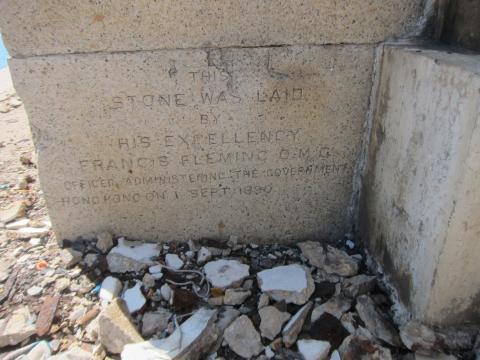
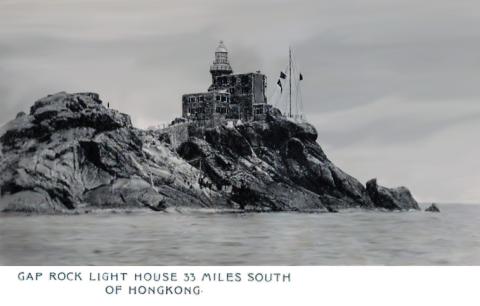

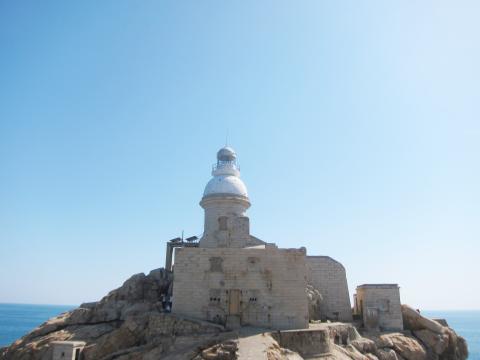



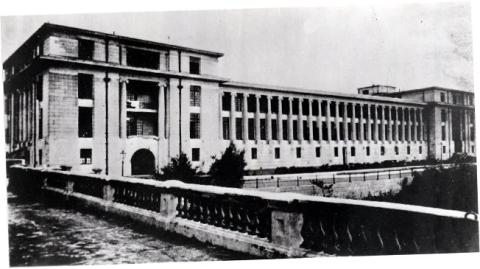
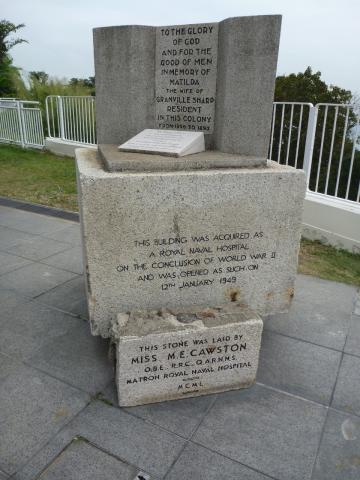
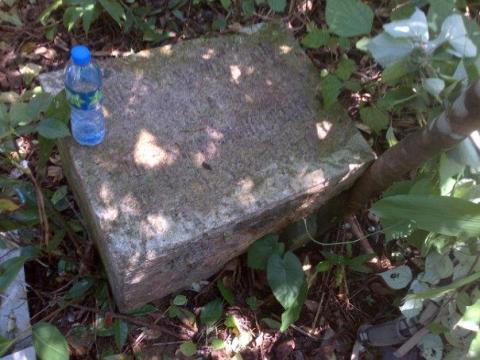
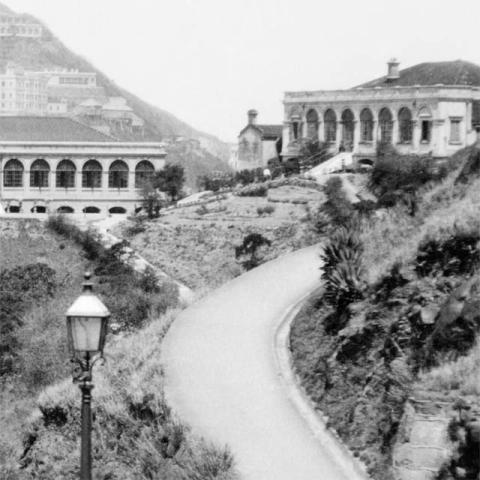
Comments
Re: Early Hong Kong Foundation Stone
Do not know what happened to the Colonial Secretariat Building Foundation Stone that was found in 1954.
China Mail 27 August 1954 - Historic Foundation Stone Unearthed.
Workmen unearthed the foundation stone of the original building which had been demolished in 1954. A bronze plaque in florid characters indicated the foundation stone was laid on _?_th day of February, 1847 by Governor Davis with Major Aldrich, Commanding Royal Engineer in attendance.
Hiram's Highway Opening Stone
https://picasaweb.google.com/Colin.Aitchison7/RoyalHongKongPoliceHongKongPolice#5552752107718334482
Re: Club Lusitano at Ice House Street
Hi there,
We have three foundation stone of the Club Lusitano at the entrance.
T
Foundation Stones
Thanks Gentlemen, some good additions to the collection there.
Hopefully that Colonial Secretariat Building Foundation Stone is tucked away somewhere safely within the modern building. Hope it didn't end up in the landfill!
Regards, David
The Hirams Highway Stone
From Bill Lake's write-up about the origin of the name Hirams Highway:
http://gwulo.com/node/32908
Commodore's Bungalow
The earlier photo's of the Commodore's Bungalow are in fact not THE bungalow as that was located higher up the ridge. When I found the foundation stone, in 1961, it was laying on the floor of what remained of the actual Bungalow and I was living in one of the other bungalows which were staff quarters for RAMC staff at Mount Kellett military hospital. These Quarters were abandoned in 1962 after Typhoon damage after which I assume they were demolished. I will try to load other photo's from that time of the bungalows,the foundation stone and a view from that point to Mount Kellett